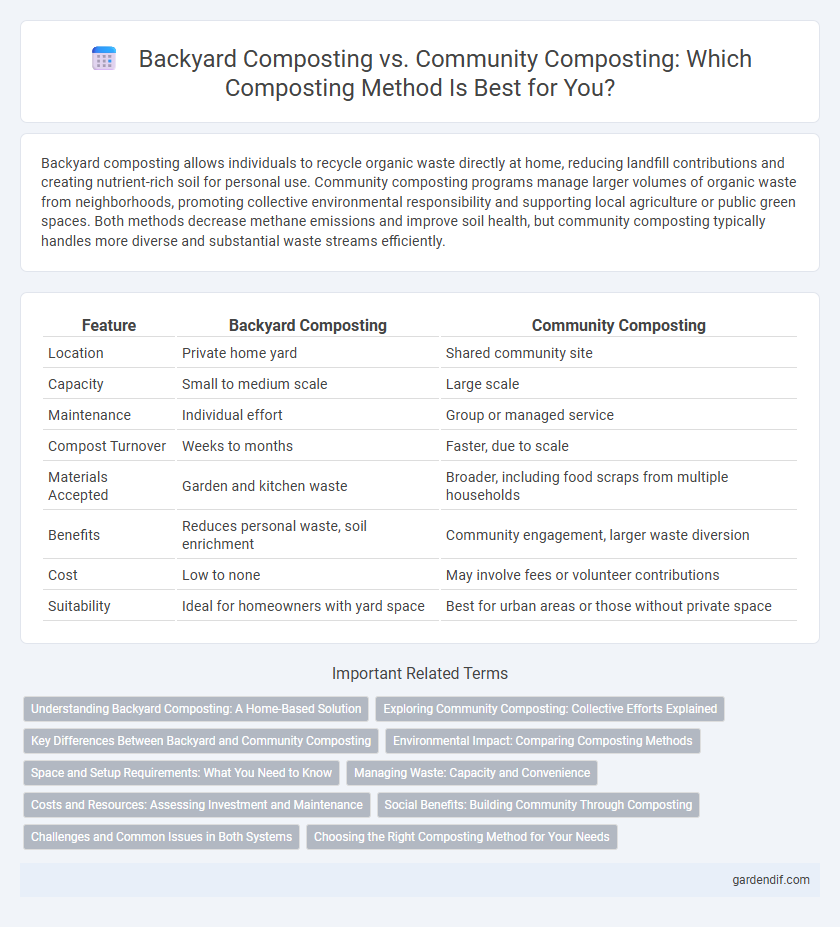
Backyard composting vs Community composting Illustration
Backyard composting allows individuals to recycle organic waste directly at home, reducing landfill contributions and creating nutrient-rich soil for personal use. Community composting programs manage larger volumes of organic waste from neighborhoods, promoting collective environmental responsibility and supporting local agriculture or public green spaces. Both methods decrease methane emissions and improve soil health, but community composting typically handles more diverse and substantial waste streams efficiently.
Table of Comparison
| Feature | Backyard Composting | Community Composting |
|---|---|---|
| Location | Private home yard | Shared community site |
| Capacity | Small to medium scale | Large scale |
| Maintenance | Individual effort | Group or managed service |
| Compost Turnover | Weeks to months | Faster, due to scale |
| Materials Accepted | Garden and kitchen waste | Broader, including food scraps from multiple households |
| Benefits | Reduces personal waste, soil enrichment | Community engagement, larger waste diversion |
| Cost | Low to none | May involve fees or volunteer contributions |
| Suitability | Ideal for homeowners with yard space | Best for urban areas or those without private space |
Understanding Backyard Composting: A Home-Based Solution
Backyard composting transforms kitchen scraps and yard waste into nutrient-rich soil amendments directly at home, reducing landfill contributions by up to 30%. This sustainable practice supports healthy plant growth while minimizing greenhouse gas emissions from organic waste. Homeowners can optimize compost quality by balancing green and brown materials, maintaining moisture, and aerating regularly.
Exploring Community Composting: Collective Efforts Explained
Community composting involves collective participation in managing organic waste, utilizing shared spaces to process food scraps and garden waste efficiently. This approach enhances environmental benefits by reducing landfill contributions, promoting nutrient-rich soil production, and fostering social collaboration among participants. Group efforts streamline composting logistics, making it accessible for urban residents and those lacking backyard space for traditional composting.
Key Differences Between Backyard and Community Composting
Backyard composting involves individuals managing organic waste at home, typically using small bins or piles, which allows for personalized control but may produce limited compost volumes. Community composting operates on a larger scale, collectively managed by neighborhoods or organizations, enabling the processing of diverse organic materials and generating substantial amounts of compost. Key differences include scale, participation level, waste diversity, and resource allocation, with backyard composting emphasizing convenience and community composting focusing on broader environmental impact.
Environmental Impact: Comparing Composting Methods
Backyard composting reduces household waste by converting kitchen scraps and yard debris into nutrient-rich soil amendments, minimizing landfill contributions and methane emissions. Community composting programs handle larger volumes of organic waste, promoting regional waste diversion and supporting local agriculture but may require more transportation, leading to a higher carbon footprint. Evaluating environmental impact involves balancing the localized benefits of backyard composting against the scalability and broader waste reduction capabilities of community composting initiatives.
Space and Setup Requirements: What You Need to Know
Backyard composting requires minimal space, often utilizing compact bins or designated garden areas, making it ideal for homeowners with limited outdoor room. Community composting demands larger, centralized setups to handle higher volumes of organic waste, often involving specialized equipment and coordination among multiple participants. Understanding these spatial and setup differences helps determine the most efficient composting method based on available resources and waste management goals.
Managing Waste: Capacity and Convenience
Backyard composting allows individuals to manage small-scale organic waste directly, offering immediate convenience but limited capacity suitable for typical household scraps. Community composting supports larger volumes of diverse waste types by pooling resources, providing scalable capacity that accommodates multiple households or neighborhoods. Choosing between these methods depends on waste volume, available space, and desired waste management efficiency.
Costs and Resources: Assessing Investment and Maintenance
Backyard composting requires minimal initial investment, typically limited to a compost bin or designated area, and involves regular personal time for turning and maintenance. Community composting demands higher upfront costs for larger infrastructure, such as collection bins and processing equipment, alongside ongoing expenses for staff and operational logistics. Both methods offer resource-saving benefits, but backyard composting is more cost-effective for individuals, whereas community composting scales efficiently for urban waste management.
Social Benefits: Building Community Through Composting
Backyard composting encourages individual responsibility and environmental awareness by allowing households to manage organic waste, fostering a personal connection to sustainability. Community composting brings neighbors together, creating shared spaces that promote social interaction, cooperative learning, and collective stewardship of local resources. Both methods enhance community bonds by encouraging participation, education, and collaboration in waste reduction efforts.
Challenges and Common Issues in Both Systems
Backyard composting faces challenges such as limited space, pest control, and inconsistent temperature maintenance, which can affect the decomposition process and compost quality. Community composting often struggles with logistical issues, including coordination among participants, contamination from non-compostable materials, and the need for regular management to prevent odor and pest problems. Both systems require ongoing education and commitment to ensure proper waste segregation and effective composting outcomes.
Choosing the Right Composting Method for Your Needs
Backyard composting offers personalized control over organic waste management, ideal for households with garden space and moderate waste production, enabling faster nutrient recycling tailored to specific soil needs. Community composting supports larger-scale organic waste diversion in urban or space-limited areas, fostering collective environmental responsibility and providing access to composting resources and education. Selecting the right composting method depends on factors such as available space, volume of organic waste, environmental goals, and the level of community engagement desired.
Backyard composting vs Community composting Infographic

 gardendif.com
gardendif.com